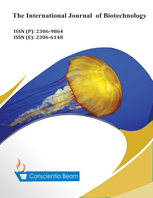Bio-Efficacy of Pupicidal Activity of Some Plant Essential Oils on Culex Quinquefasciatus and Anopheles Stephensi
Abstract
Bio-efficacy of pupicidal potential of some essential oils from seven plants (Pimpinella anisum, Cinnamomum veerum, Myrtus caryophyllus, Citrus sinensis, Thymus vulgaris, Ocimum sanctum and Vetiveria zizanioides) was tested against the pupae of Culex quinquefasciatus and Anopheles stephensi. The pupal susceptibility test were carried out using WHO standard method. In the pupicidal assay at five different concentrations viz., 31.25, 62.5, 125, 250, and 500ppm concentrations were used andthe mortality was observed after 24-h exposure. All the tested essential oils showed moderate to good pupicidal activity. However, the maximum pupal mortality was registered at 500 ppm concentration as 100 ± 0.00% for Cx. quinquefasciatus and An. stephensi respectively. The Pupal mortality was resigered as of aniseed (87.5 ± 062%), tulsi (85.0 ± 0.72%) and cinnamom (82.2 ± 0.42%) at 500 ppm for Cx. quinquefasciatus respectively. The efficacy results of pupal mortality of aniseed (85.2 ± 023%), tulsi (84.1 ± 0.23%) and cinnamom (80.1 ± 0.51%) at 500 ppm for An. stephensi respectively. The LC50 and LC90 of clove oil (106.3 and 313.3 ppm), tulsi (133.6 and 539.3 ppm) and cinnamon (141.0 and 575.5 ppm) against Cx. quinquefasciatus after 24 h respectively, and LC50 values of 110.5, 144.2 and 150.1 ppm and LC90 values of 310.4, 502.3 and 603.0 ppm against An. stephensi after 24 h of treatment, respectively. The results suggest that the essential oils have potential to be used as a pupicidal activity an ideal eco-friendly approach for the control of filarial and malaria vectors, Cx. quinquefasciatus and An. stephensi as target species in vector borne diseases control programs.

